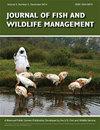美国东南部冬季活动的两种蝙蝠的运动模式
IF 0.9
4区 环境科学与生态学
Q4 BIODIVERSITY CONSERVATION
引用次数: 0
摘要
在美国东南部,许多易患白鼻综合症的海绵蝙蝠在冬季会周期性地从冬眠中醒来,偶尔也会离开冬眠地。研究了白鼻综合征流行期间持续存在的灰蝙蝠(Myotis grisescens)和东部小脚蝙蝠(M. leibii)的冬季活动和生境利用情况。我们在冬眠室外捕获的蝙蝠身上放置了高频无线电发射器,以调查它们在冬季的活动,其中可能包括觅食。从洞穴入口释放蝙蝠开始,研究人员对它们进行了跟踪,直到它们的发射机信号消失,或者它们静止不动了大约15分钟。灰蝠(n = 12)的核心活动范围为1.92 km2,总活动范围为30.93 km2。东部小足蝠(n = 5)的核心活动范围为1.98 km2,总活动范围为20.22 km2。灰蝙蝠在核心范围内使用开阔的土地覆盖类型多于预期,但在其整个范围内选择水和森林覆盖类型(P < 0.001)。东部小足蝙蝠在核心范围内与预期相同(P = 0.1988),但在整个范围内选择了发达和开放的土地覆盖类型(P < 0.001)。灰蝙蝠和灰蝙蝠都在靠近冬眠地的地方飞行,并使用道路飞行(P < 0.005),灰蝙蝠也在靠近水道飞行(P < 0.001)。栖息地管理和提高冬眠期附近全年猎物可得性可能有利于蝙蝠种群,特别是在冬季,当猎物资源少,蝙蝠因冬眠和白鼻综合征而受到生理压力时。本文章由计算机程序翻译,如有差异,请以英文原文为准。
Movement Patterns of Two Bat Species Active during Winter in the Southeastern United States
During winter in the southeastern United States cavernicolous bats, many species of which are susceptible to white-nose syndrome, periodically arouse from torpor and occasionally leave hibernacula. We investigated the winter movements and habitat use of two bat species persisting during the white-nose syndrome epizootic, the gray bat, Myotis grisescens, and the eastern small-footed bat, M. leibii. We deployed very high frequency radio transmitters on individual bats captured outside hibernacula to investigate activity, which may include foraging, during winter. Bats were tracked from release at the cave entrance until their transmitter signal was lost or they remained stationary for >15 minutes. Gray bats (n = 12) had a core range of 1.92 km2 and an overall range of 30.93 km2. Eastern small-footed (n = 5) bats had a core range of 1.98 km2 and an overall range of 20.22 km2. Gray bats used open landcover types more than expected based on availability in the core range, but selected water and forest cover types in their overall range (P < 0.001). Eastern small-footed bats used available landcover types as expected in the core range (P = 0.1988) but selected for developed and open landcover types within the overall range (P < 0.001). Both species remained close to the hibernaculum and used roads when flying (P < 0.005), with gray bats also flying near waterways (P < 0.001). Habitat management and the enhancement of year-round prey availability adjacent to hibernacula may benefit bat populations, especially during winter when prey resources are low and bats are physiologically stressed due to hibernation and white-nose syndrome.
求助全文
通过发布文献求助,成功后即可免费获取论文全文。
去求助
来源期刊

Journal of Fish and Wildlife Management
BIODIVERSITY CONSERVATION-ECOLOGY
CiteScore
1.60
自引率
0.00%
发文量
43
审稿时长
>12 weeks
期刊介绍:
Journal of Fish and Wildlife Management encourages submission of original, high quality, English-language scientific papers on the practical application and integration of science to conservation and management of native North American fish, wildlife, plants and their habitats in the following categories: Articles, Notes, Surveys and Issues and Perspectives. Papers that do not relate directly to native North American fish, wildlife plants or their habitats may be considered if they highlight species that are closely related to, or conservation issues that are germane to, those in North America.
 求助内容:
求助内容: 应助结果提醒方式:
应助结果提醒方式:


